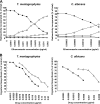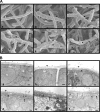Mechanism of action of efinaconazole, a novel triazole antifungal agent
- PMID: 23459486
- PMCID: PMC3632939
- DOI: 10.1128/AAC.02063-12
Mechanism of action of efinaconazole, a novel triazole antifungal agent
Abstract
The mechanism of action of efinaconazole, a new triazole antifungal, was investigated with Trichophyton mentagrophytes and Candida albicans. Efinaconazole dose-dependently decreased ergosterol production and accumulated 4,4-dimethylsterols and 4α-methylsterols at concentrations below its MICs. Efinaconazole induced morphological and ultrastructural changes in T. mentagrophytes hyphae that became more prominent with increasing drug concentrations. In conclusion, the primary mechanism of action of efinaconazole is blockage of ergosterol biosynthesis, presumably through sterol 14α-demethylase inhibition, leading to secondary degenerative changes.
Figures



References
-
- Rodriguez RJ, Low C, Bottema CDK, Parks LW. 1985. Multiple functions for sterols in Saccharomyces cerevisiae. Biochim. Biophys. Acta 837:336–343 - PubMed
-
- Nozawa Y, Morita T. 1986. Molecular mechanisms of antifungal agents associated with membrane ergosterol, dysfunction of membrane and inhibition of ergosterol biosynthesis, p 111–122 In Iwata K, Vanden Bossche H. (ed), In vitro and in vivo evaluation of antifungal agents: international symposium proceedings. Elsevier Science Publishers, Amsterdam, The Netherlands
-
- Parks LW, Smith SJ, Crowly JH. 1995. Biochemical and physiological effects of sterol alterations in yeast—a review. Lipids 30:227–230 - PubMed
-
- Elewski BE, Rich P, Pollak R, Pariser DM, Watanabe S, Senda H, Ieda C, Smith K, Pillai R, Ramakrishna T, Olin JT. 2012. Efinaconazole 10% solution in the treatment of toenail onychomycosis: two phase III multicenter, randomized, double-blind studies. J. Am. Acad. Dermatol. doi:10.1016/j.jaad.2012.10.013 - DOI - PubMed
MeSH terms
Substances
LinkOut - more resources
Full Text Sources
Other Literature Sources

